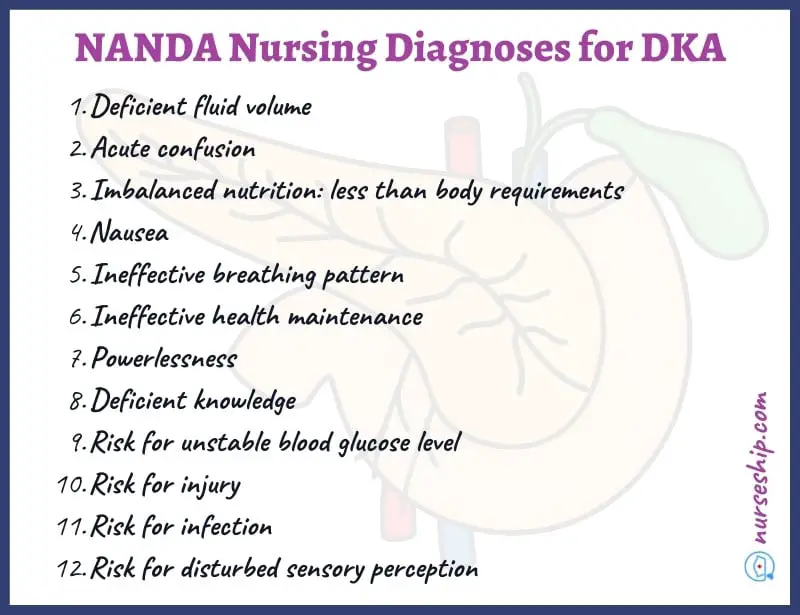Last updated on December 28th, 2023
In this post, you will find 12 NANDA-I nursing diagnosis for Diabetic Keto Acidosis (DKA). These include actual and risk nursing diagnoses.
DKA nursing assessment, interventions, priorities, and patient teaching are all included.
List of NANDA-I nursing diagnosis for Diabetic Keto Acidosis (DKA)
- Deficient fluid volume
- Acute confusion
- Imbalanced nutrition: less than body requirements
- Nausea
- Ineffective breathing pattern
- Ineffective health maintenance
- Powerlessness
- Deficient knowledge
- Risk for unstable blood glucose level
- Risk for injury
- Risk for infection
- Risk for disturbed sensory perception
Sample nursing care plan for DKA
Actual NANDA nursing diagnosis for DKA
#1 Deficient fluid volume
| May be related to | As evidenced by |
| Osmotic diuresis, excessive gastric losses | Polyuria, nausea and vomiting, diaphoresis, kussmaul respirations |
#2 Acute confusion
| May be related to | As evidenced by |
| Acidosis, dehydration | Patient not oriented, agitation, lethargy, increased intracranial pressure, headache, dry skin and mucous membranes, loss of skin turgor |
#3 Imbalanced nutrition: less than body requirements
| May be related to | As evidenced by |
| Inability to utilize glucose (insulin dependence), decreased oral intake, altered consciousness level, infectious process, anorexia, abdominal pain | Hyperglycemia of above 250mg/dl, inadequate food intake, increased ketones, increased urinary output, diarrhea |
#4 Nausea
| May be related to | As evidenced by |
| Bad, sour taste in the mouth | Vomiting, uremia, presence of ketones in urine, gagging sensation and frequent urination |
#5 Ineffective breathing pattern
| May be related to | As evidenced by |
| Excessive ketone bodies in the blood | presence of kussmaul breathing pattern, restlessness, oxygen saturation <90% |
#6 Ineffective health maintenance
| May be related to | As evidenced by |
| Complex medical regimen, lack of knowledge on diabetes, new/unfamiliar disease process | Development of preventable complications |
#7 Powerlessness
| May be related to | As evidenced by |
| Dependence on others, chronic illness, | Non-participation in care and decision making, social withdrawal, anger, expression of having no control over the situation, depression over complications despite following through with regimen |
#8 Deficient knowledge
| May be related to | As evidenced by |
| New/unfamiliar disease process, inadequate knowledge about dietary restrictions | Verbalization of incorrect statements, asking for information, development of preventable complications |
Risk nursing diagnosis for Diabetic Ketoacidosis (DKA)
#1 Risk for unstable blood glucose level
Associated risk factors
- Excessive physiological or psychological stress
- Non-adherence to the treatment regimen
- Poor diabetic self-management
- Undiagnosed diabetes mellitus
- Alcohol or drug use
- Inadequate knowledge of disease process, management, and complications
#2 Risk for infection
Associated risk factors
- Peripheral nerve damage
- Reduced peripheral tissue perfusion
- Invasive procedures
#3 Risk for injury
Associated risk factors
- confusion
- hypoglycemia
- vascular insufficiency
- blurred vision
#4 Risk for disturbed sensory perception
Associated risk factors
- Electrolyte imbalance
- Glucose/insulin imbalance

Nursing Priorities for a patient with DKA
- Rehydration therapy
- Insulin therapy
- Correction of acid-base imbalance
- Correction of electrolyte imbalance
- Treatment of cerebral edema and underlying comorbidities
Nursing management for Diabetic Ketoacidosis (DKA)
Nursing assessment for DKA
- Monitor blood glucose levels
- Assess vital signs
- Monitor electrolytes and blood gasses
- Monitor ketones
- Asses kidney function and urine output
- Assess mental status
- Asses understanding of diabetes diagnosis
- Check for underlying infections
- Take a comprehensive history once the patient is stable
Nursing interventions for diabetic ketoacidosis (DKA)
- Start two large bore IV cannulas
- Administer aggressive isotonic solutions initially (0.9% Normal saline) as prescribed.
- Continue fluid therapy as advised.
- Replace electrolytes
- Give oral fluids if tolerable
- Closely observe for the signs of fluid overload (such as presence of rales and crackles).
- Monitor and maintain intake and output chart
- Reassure patient and family
- Orient patient to surrounding if confused
Patient teaching for Diabetic Ketoacidosis
- Educate the patient on the importance of compliance with medication and insulin therapy
- Educate on warning signs of hyperglycemia.
- Educate the patient on the importance of follow up
- Educate on insulin injection self-administration
- Encourage the patient to quit smoking and abstain from alcohol
- Encourage a healthy diet; high fiber, low in carbs, fats, and sugars
- Advice the patient to wear an ID bracelet signifying that he or she has had a DKA episode
- Carry out a family teaching session to enforce first aid and prevention measures for DKA episodes.
Sample nursing care plan for Diabetic Ketoacidosis (DKA)
Conclusion
To sum up, you now know 12 NANDA-I nursing diagnosis for diabetic ketoacidosis that you can use in your nursing care plans.
Additionally, you have also learned about nursing assessment, nursing interventions, nursing priorities, and patient teaching for DKA.
Reference
Ackley, B., Ladwig, G., Makic, M., Martinez-Kratz, M., & Zanotti, M. (2020). Nursing Diagnoses Handbook: An Evidence-based Guide to Planning Care (12th ed.). Elsevier.
Gulanick, M., & Myers, J. L. (2022). Nursing care plans: Diagnoses, interventions, and outcomes. Elsevier Health Sciences.
Herdman, T., Kamitsuru, S. & Lopes, C. (2021). NURSING DIAGNOSES: Definitions and Classifications 2021-2023 (12th ed.). Thieme.
Swearingen, P. (2016). ALL-IN-ONE Nursing Care Planning Resource (4th ed.). Elsevier/Mosby.


